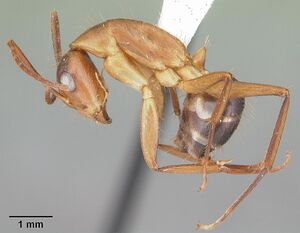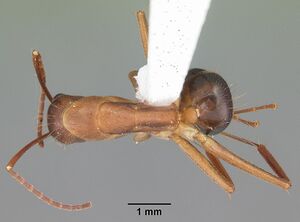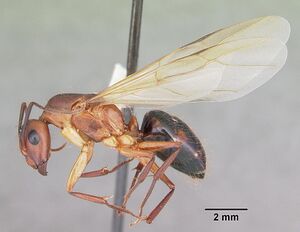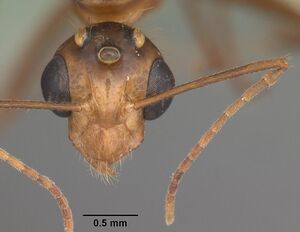Camponotus inaequalis
| Camponotus inaequalis | |
|---|---|

| |
| Scientific classification | |
| Kingdom: | Animalia |
| Phylum: | Arthropoda |
| Class: | Insecta |
| Order: | Hymenoptera |
| Family: | Formicidae |
| Subfamily: | Formicinae |
| Tribe: | Camponotini |
| Genus: | Camponotus |
| Species: | C. inaequalis |
| Binomial name | |
| Camponotus inaequalis Roger, 1863 | |
| Synonyms | |
| |
Identification
Keys including this Species
Distribution
Latitudinal Distribution Pattern
Latitudinal Range: 28.546° to 24.555°.
| North Temperate |
North Subtropical |
Tropical | South Subtropical |
South Temperate |
- Source: AntMaps
Distribution based on Regional Taxon Lists
Nearctic Region: United States (type locality).
Neotropical Region: Cuba (type locality), Mexico.
Distribution based on AntMaps
Distribution based on AntWeb specimens
Check data from AntWeb
Countries Occupied
| Number of countries occupied by this species based on AntWiki Regional Taxon Lists. In general, fewer countries occupied indicates a narrower range, while more countries indicates a more widespread species. |

|
Estimated Abundance
| Relative abundance based on number of AntMaps records per species (this species within the purple bar). Fewer records (to the left) indicates a less abundant/encountered species while more records (to the right) indicates more abundant/encountered species. |

|
Biology
The phylogeography of a group of Pacific Island Camponotus species, which included a number of species groups, was broadly examined by Clouse et al. (2015). They found Camponotus tortuganus is the basal member of a group of species spanning an area from Florida to New Guinea. Also, these species as a clade appear to be part of a larger Neotropical lineage.
Flight Period
| X | |||||||||||
| Jan | Feb | Mar | Apr | May | Jun | Jul | Aug | Sep | Oct | Nov | Dec |
Source: antkeeping.info. Notes: as Camponotus tortuganus (March).
- Check details at Worldwide Ant Nuptial Flights Data, AntNupTracker and AntKeeping.
 Explore: Show all Flight Month data or Search these data. See also a list of all data tables or learn how data is managed.
Explore: Show all Flight Month data or Search these data. See also a list of all data tables or learn how data is managed.
Life History Traits
- Queen number: monogynous (Frumhoff & Ward, 1992)
Castes
Worker
Images from AntWeb
   
| |
| Worker. Specimen code casent0103717. Photographer April Nobile, uploaded by California Academy of Sciences. | Owned by ABS, Lake Placid, FL, USA. |
   
| |
| Queen (alate/dealate). Specimen code casent0103721. Photographer April Nobile, uploaded by California Academy of Sciences. | Owned by ABS, Lake Placid, FL, USA. |
Queen
Images from AntWeb
    
| |
| Queen (alate/dealate). Specimen code casent0103719. Photographer April Nobile, uploaded by California Academy of Sciences. | Owned by ABS, Lake Placid, FL, USA. |
Male
Images from AntWeb
   
| |
| Male (alate). Specimen code casent0103720. Photographer April Nobile, uploaded by California Academy of Sciences. | Owned by ABS, Lake Placid, FL, USA. |
Nomenclature
The following information is derived from Barry Bolton's Online Catalogue of the Ants of the World.
- inaequalis. Camponotus inaequalis Roger, 1863a: 147 (w.q.) CUBA.
- Type-material: syntype minor workers, syntype queen(s) (numbers not stated).
- Type-locality: Cuba: (no further data) (J.C. Gundlach).
- Type-depository: unknown.
- [Note: Roger type-material is principally in DEIB, MNHN, MNHU, ZSBS.]
- Combination in C. (Myrmoturba): Forel, 1914a: 267;
- combination in C. (Tanaemyrmex): Emery, 1925b: 80.
- Subspecies of conspicuus: Forel, 1914a: 267; Emery, 1925b: 80; Kempf, 1972a: 66; Bolton, 1995b: 104.
- Status as species: Roger, 1863b: 5; Mayr, 1863: 458; Dalla Torre, 1893: 236; Emery, 1896d: 371, 378 (in list); Wheeler, W.M. 1905b: 134; Wheeler, W.M. 1913b: 503; Alayo, 1974: 27 (in key); Deyrup, 2017: 193.
- Senior synonym of tortuganus: Deyrup, 2017: 193.
- Material of the unavailable name eburneus referred here by Wheeler, W.M. 1913b: 503 (in text); Kempf, 1972a: 65; Bolton, 1995b: 104.
- Distribution: Bahamas, Cuba, U.S.A.
- tortuganus. Camponotus maculatus subsp. tortuganus Emery, 1895c: 336 (w.) U.S.A. (Florida).
- Type-material: holotype minor worker.
- Type-locality: U.S.A.: Florida, Dry Tortugas (T. Pergande).
- [Note: Wheeler, W.M. 1932a: 13, unnecessarily designates this as type-locality.]
- Type-depository: MSNG.
- Wheeler, W.M. 1910d: 310 (s.q.m.).
- Combination in C. (Tanaemyrmex): Emery, 1925b: 80.
- Subspecies of maculatus: Emery, 1896d: 371 (in list); Wheeler, W.M. 1910d: 310; Wheeler, W.M. 1910g: 571; Smith, M.R. 1930a: 6.
- Subspecies of picipes: Emery, 1920b: 233 (footnote).
- Subspecies of conspicuus: Emery, 1925b: 80.
- Status as species: Wheeler, W.M. 1932a: 13; Creighton, 1950a: 380; Smith, M.R. 1951a: 843; Wilson, 1964b: 12; Smith, D.R. 1979: 1430; Deyrup, et al. 1989: 100; Bolton, 1995b: 127; Deyrup, 2003: 44; Hansen & Klotz, 2005: 97; Mackay & Delsinne, 2009: 497 (in key).
- Junior synonym of inaequalis: Deyrup, 2017: 193.
Type Material
- Camponotus maculatus tortuganus: Syntype, a long series of specimens of all four phases, Miami, Florida, United States, Wheeler, W.M., Museum of Comparative Zoology; single colony.
Taxonomic Notes
Deyrup, Davis & Cover (2000) - Structurally, C. inaequalis Roger is almost identical to Camponotus maculatus tortuganus from Florida, but the typical red and black coloration of C. tortuganus does not match the coloration of C. inaequalis that we have seen from the Bahamas. Our guess is that C. tortuganus is either a native Florida geographic isolate of C. inaequalis, or it represents a form of C. conspicuus imported from outside the range of C. inaequalis. We have seen a series from the Florida Keys that is colored exactly like Bahamian C. inaequalis (Deyrup et al. 1988), but we are not quite ready to add this to our list of Florida exotics until the taxonomic status of this complex is a little clearer. Nature may outpace taxonomists: the experiment to test whether C. tortuganus and C. inaequalis are reproductively isolated may already be under way in the Florida Keys.
Deyrup (2017) - The taxonomy of this species, along with C. tortuganus and Camponotus zonatus, is both tedious and unresolved. In desperation, I am reverting to the oldest plausible name: inaequalis. Perhaps this designation will encourage future taxonomic work on this and related species throughout the range of all involved taxa.
Description
Worker
Wheeler (1910, as Camponotus maculatus tortuganus) – Major Length, 9-11 mm.; head; 2.6 x 2.3 mm.; scape, 2.2 mm.; hind tibia, 2.8 mm.
Head rather long and narrow, with very feebly convex sides, Eyes large, moderately convex. Mandibles 7-toothed. Clypeus strongly carinate, the lobe of its anterior border moderately produced, rather narrow, with very faintly sinuous median edge and rounded lateral corners. Frontal carinae lyrate, rather closely approximated. Antennal scapes terete at the base, neither dilated nor flattened, enlarged towards their tips. Thorax slender, low, evenly arched above in profile; epinotum with the base fully twice as long as the declivity, which is slightly concave. Petiole rather high and narrow, with convex anterior and flattened posterior surface and blunt lateral and upper border. Legs rather long; middle and hind tibiae triangular in cross-section, with sulcate anterior surface.
Head, thorax and petiole subopaque, very densely and finely shagreened. Mandibles shining, coarsely striato-punctate. Anterior border of cheeks and clypeus shining, cheeks and sides of head with small, elongate punctures or foveolae; clypeus and inner borders of frontal carinae, pro- and mesonotum with a few coarse piligerous punctures. Gaster finely and superficially shagreened, shining.
Hairs yellowish, erect, moderately abundant on the dorsal surface, very short and appressed on the antennal scapes and legs; femora with a few long hairs on their flexor surfaces; bristles lacking on the flexor surfaces of the tibiae. Cheeks without erect hairs, those on the anterior border of the clypeus short and inconspicuous. Funiculi with very minute erect hairs. Pubescence very sparse, short on the head and thorax, somewhat longer on the gaster.
Ferruginous brown; head darker than the thorax, and the upper surface of the latter often darker than the pleurae. Mandibles and anterior borders of cheeks and clypeus blackish. Scapes infuscated except at the base. Gaster black or dark brown, venter, base of first segment and posterior margins of segments paler. Coxae and femora yellow, tibiae and tarsi ferruginous.
Minor Length, 6-7 mm.
Head very long, more than twice as long as broad, excluding the mandibles, somewhat narrowed behind in the occipital region; cheeks long, parallel. Clypeus like that of the worker major. Thorax very slender; base of epinotum more than three times as long as the declivity.
Head, thorax and petiole more shining than in the worker major, paler and more yellowish brown; head somewhat darker, mandibles brown. Gaster and legs colored as in the worker major. Pilosity also Similar, but there are no minute erect hairs on the antennal funiculi. Cheeks without foveolae or only with a few faint elongate punctures.
Queen
Wheeler (1910, as Camponotus maculatus tortuganus) - Length of body, 10-11 mm.; of wings, 11 mm.
Resembling the worker major in sculpture, pilosity and color. Head proportionately longer. Eyes large and convex. Thorax as broad as the head, rather depressed; epinotum withl indistinct base and declivity, the former fully as long as the latter. Petiole similar to that of the worker major.
Wings suffused with sordid yellow; veins and stigma pale brownish yellow.
Male
Wheeler (1910, as Camponotus maculatus tortuganus) - Length, 7 mm.
Head through the eyes about as broad as long. Eyes and ocelli very large. Cheeks much shorter than the eyes, straight and parallel. Posterior portion of head broad and rounded. Clypeus sub carinate, with broadly rounded, projecting anterior border. Mandibles narrow, edentate. Antennae slender, first funicular joint as long as the second, distinctly incrassated. Thorax robust, with low, evenly rounded epinotum; its base and declivity indistinctly differentiated, the former about twice as long as the latter. Petiole longer than high, with a low, thick, transverse node. Gaster and legs slender.
Head and thorax subopaque or somewhat shining, especially the pleurae and the front of the head, very minutely and indistinctly shagreened; gaster shining.
Hairs yellow, erect, rather long and abundant on the head and gaster, petiole and epinotum, sparse on the remainder of the thorax. Legs and antennae naked. Pubescence rather long on the gaster, but inconspicuous or absent elsewhere.
Head yellowish brown beneath and behind, with a large dark brown or black spot, on the vertex. Antennae, thorax, petiole and legs brown; gaster dark brown or blackish, with paler posterior margins to the segments; mouthparts and genitalia yellowish. Wings dull whitish, with pale yellow veins and stigma.
References
- Deyrup, M. 2017. Ants of Florida: Identification and Natural History. CRC Press, 423 pp.
- Deyrup, M., Davis, L. & Cover, S. 2000. Exotic ants in Florida. Transactions of the American Entomological Society 126, 293-325.
- Deyrup, M.A., Carlin, N., Trager, J., Umphrey, G. 1988. A review of the ants of the Florida Keys. Florida Entomologist 71: 163-176.
- Emery, C. 1925d. Hymenoptera. Fam. Formicidae. Subfam. Formicinae. Genera Insectorum 183: 1-302 (page 80, Combination in C. (Tanaemyrmex))
- Fontenla, J.L., Brito, Y.M. 2011. Hormigas invasoras y vagabundas de Cuba. Fitosanidad 15(4), 253-259.
- Forel, A. 1914a. Le genre Camponotus Mayr et les genres voisins. Rev. Suisse Zool. 22: 257-276 (page 267, Combination in C. (Myrmoturba))
- Forel, A. 1914a. Le genre Camponotus Mayr et les genres voisins. Rev. Suisse Zool. 22: 257-276 (page 267, Subspecies of conspicuus)
- Oswalt, D.A. 2007. Nesting and foraging characteristics of the black carpenter ant Camponotus pennsylvanicus DeGeer (Hymenoptera: Formicidae). Ph.D. thesis, Clemson University.
- Roger, J. 1863a. Die neu aufgeführten Gattungen und Arten meines Formiciden-Verzeichnisses nebst Ergänzung einiger früher gegebenen Beschreibungen. Berl. Entomol. Z. 7: 131-214 (page 147, worker, queen described)
- Wheeler, W. M. 1910g. The North American ants of the genus Camponotus Mayr. Ann. N. Y. Acad. Sci. 20: 295-354.
- Wheeler, W. M. 1913b. The ants of Cuba. Bulletin of the Museum of Comparative Zoology 54: 477-505 (page 503, Material of the unavailable name eburneus referred here (in text))


